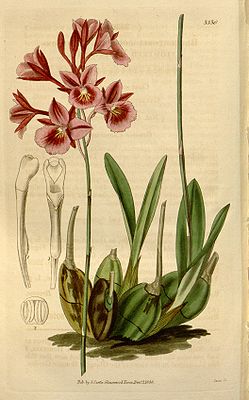Broughtonia
| Broughtonia | ||||||||||||
|---|---|---|---|---|---|---|---|---|---|---|---|---|

Broughtonia sanguinea , illustration |
||||||||||||
| Systematics | ||||||||||||
|
||||||||||||
| Scientific name | ||||||||||||
| Broughtonia | ||||||||||||
| R.Br. |
The genus Broughtonia the family of orchids (Orchidaceae) includes six plant species that occur on different islands of the Caribbean. The small, perennial plants grow epiphytically . They are cultivated occasionally and numerous hybrids have been bred with Broughtonia sanguinea in particular .
description
All species of this genus are evergreen, perennial herbaceous plants. The roots arise from a rhizome and are surrounded by a four to six cell layer thick velamen . The pseudobulbs are close together on the rhizome, they consist of several internodes . The pseudobulbs and rhizome are surrounded by dry lower leaves. The leaves - one or two per pseudobulb are present - are oval to lanceolate in shape, leathery to fleshy and, in some species, have rough teeth on the edge. The terminal inflorescence clearly towers above the leaves, at the end it bears five to 20 resupinated flowers in a raceme or slightly branched panicle . The flower color is generally pink, the lip has a yellow spot. The sepals are lanceolate, the petals clearly wider and slightly wavy at the edge. All petals are free. The lip is unlobed or indistinctly three-lobed, rolled up around the column at the base , otherwise spread out flat. The edge of the lip is curled and puckered, the tip sometimes drawn in. A yellow spot and a yellow-colored, keeled callus extend from the base of the lip to the middle. At the base the lip merges into a tubular or sack-shaped nectarium , which is either visible from the outside as a bulge or can be completely fused with the ovary . The end of the column is widened laterally, and in some species it is also provided with two humps at the base. There are four equally large or eight unequal sized pollinia .
The number of chromosomes is 2n = 40.
distribution
The species colonize various Caribbean islands, Cuba , the Bahamas , Jamaica , Hispaniola , Mona Island and Puerto Rico . There they grow epiphytically in dry forests, thorn bushes and cactus communities, sometimes in more humid places. The locations are mostly in full sun.
Systematics and botanical history
The genus Broughtonia is classified in the Subertribus Laeliinae . The genera Psychilis , Quisqueya and Tetramicra are closely related . Although Broughtonia only includes six species, some authors divide them into three genera. Each of these three genera is monophyletic in itself and inhabits a geographically delimited area, but the amalgamation of all three genera as well.
Robert Brown established the genus Broughtonia in 1813 . He probably wanted to honor the English doctor and botanist Arthur Broughton (approx. 1758 - 1796). Type species of the genus is Broughtonia sanguinea . This had already been described by Olof Peter Swartz as Epidendrum sanguineum . The genus Laeliopsis was established by Lindley in 1853 , and Cattleyopsis also by Lemaire in 1853 . All six species have been shifted back and forth between these three genera one or more times.
species
The following species were recognized:
- Broughtonia cubensis (Lindl.) Cogn. , western Cuba
- Broughtonia domingensis (Lindl.) Rolfe , Hispaniola, Mona Island, Puerto Rico
- Broughtonia lindenii (Lindl.) Dressler , Cuba and Bahamas
- Broughtonia negrilensis Fowlie , Jamaica
- Broughtonia ortgesiana (Rchb.f.) Dressler , Cuba
- Broughtonia sanguinea (Sw.) R.Br. , Jamaica
The natural hybrid Broughtonia × jamaicense Sauleda & RMAdams occurs between Broughtonia negrilensis and Broughtonia sanguinea . There are also hybrids between Broughtonia domingensis and Psychilis olivacea .
Culture
Both the species can be found in culture as well as numerous hybrids with related genera. Broughtonia sanguinea in particular was used for breeding purposes. The Broughtonia species inherit a number of desirable traits such as intense flower color and flat, round flowers. They need a lot of light and warmth in culture and are sensitive if they don't dry off quickly after watering.
literature
- Alec M. Pridgeon, Phillip Cribb , Mark W. Chase: Genera Orchidacearum . Vol. 4/1: Epidendroidae (Part one) . Oxford University Press, 2005. pp. 210-213. ISBN 0-19-850712-7
- Withner, CL (1996): The Cattleyas and their relatives. Volume IV. The Bahamian and Caribbean Species. Timber Press, Portland. ISBN 0-88192-344-3 . Pp. 15-29, 81-84.
Individual evidence
- ^ Van den Berg, C. & Chase, MW (2004): A reappraisal of Laeliinae: taxonomic history, phylogeny and new generic alliances. Orchid Digest 68 (4): 223. Online, PDF ( Memento of the original from September 26, 2007 in the Internet Archive ) Info: The archive link was inserted automatically and has not yet been checked. Please check the original and archive link according to the instructions and then remove this notice.
- ↑ Lotte Burkhardt: Directory of eponymous plant names . Extended Edition. Botanic Garden and Botanical Museum Berlin, Free University Berlin Berlin 2018. [1]
- ^ WT Aiton: Hortus Kewensis; Or, A Catalog of the Plants Cultivated in the Royal Botanic Garden at Kew. The second edition. 5: 217. London 1813
- ↑ a b c d e f g Rafaël Govaerts (Ed.): Broughtonia. In: World Checklist of Selected Plant Families (WCSP) - The Board of Trustees of the Royal Botanic Gardens, Kew . Retrieved April 6, 2020.


